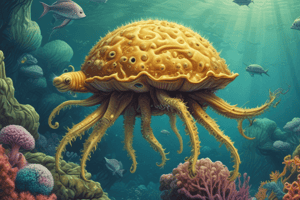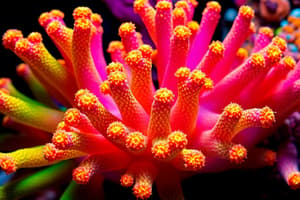Podcast
Questions and Answers
How was the first animal created?
How was the first animal created?
- Through fossil records
- Through evolution
- Through chemical reactions
- Through cells developing a language (correct)
What modern animal can we study to learn about the first animal?
What modern animal can we study to learn about the first animal?
Sponge
What do sponges thrive in?
What do sponges thrive in?
Salt and freshwater
What evidence tells us that sponges are animals?
What evidence tells us that sponges are animals?
What can sponge cells do that other animals cannot?
What can sponge cells do that other animals cannot?
How does a sponge skeleton differ from ours?
How does a sponge skeleton differ from ours?
What are spicules?
What are spicules?
What are choanocytes?
What are choanocytes?
What does pumping do for the sponge?
What does pumping do for the sponge?
Why are single-celled organisms not classified as animals?
Why are single-celled organisms not classified as animals?
What happens to the cells of a sponge after being broken by a sieve?
What happens to the cells of a sponge after being broken by a sieve?
In what ways are sponges like other animals?
In what ways are sponges like other animals?
How much water does a sponge need to pump to filter out 1 ounce of food?
How much water does a sponge need to pump to filter out 1 ounce of food?
How is the sponge's pump powered?
How is the sponge's pump powered?
What is collagen?
What is collagen?
What are sponges' bodies held together by?
What are sponges' bodies held together by?
What kingdom do sponges belong to?
What kingdom do sponges belong to?
What is another name for the sponge?
What is another name for the sponge?
What is the place that the water goes into called?
What is the place that the water goes into called?
What is the large opening that water goes out of known as?
What is the large opening that water goes out of known as?
What lines the inside of the sponge's body cavity?
What lines the inside of the sponge's body cavity?
What do amebocytes do?
What do amebocytes do?
What is the sponge's level of organization?
What is the sponge's level of organization?
Most sponges are what?
Most sponges are what?
Most sponges live in?
Most sponges live in?
Sponges are heterotrophs meaning they cannot do what?
Sponges are heterotrophs meaning they cannot do what?
What kind of feeders are sponges?
What kind of feeders are sponges?
Do sponges have digestive tracts?
Do sponges have digestive tracts?
How do sponges digest food?
How do sponges digest food?
The inside body cavity of a sponge is known as?
The inside body cavity of a sponge is known as?
The sponge has how many cell layers?
The sponge has how many cell layers?
How do sponges respire?
How do sponges respire?
How do they transport material?
How do they transport material?
How do sponges excrete waste products?
How do sponges excrete waste products?
When is the one time in a sponge's life that it can move?
When is the one time in a sponge's life that it can move?
How do sponges reproduce asexually?
How do sponges reproduce asexually?
Most sponges are monoecious meaning they have what?
Most sponges are monoecious meaning they have what?
What does mesenchyme refer to?
What does mesenchyme refer to?
Flashcards are hidden until you start studying
Study Notes
Origins and Characteristics of Sponges
- First animals emerged through cellular communication and development.
- Sponges inhabit both salt and freshwater environments, thriving in tropical and polar regions.
- Evidence of sponges being animals includes their heterotrophic nature, presence of collagen, cellular communication, sexual reproduction, and multicellularity.
Sponge Regeneration and Structure
- Sponge cells have the unique ability to reform and regenerate if damaged.
- Sponge skeletons comprise spicules made of materials like calcium carbonate or silica.
Sponge Anatomy and Function
- Spicules provide structural rigidity to the sponge.
- Choanocytes are specialized cells with flagella that facilitate water pumping, essential for feeding and reproduction.
- Sponges lack organs; their bodies consist of millions of cells that cooperate for survival.
- The sponge body is held together by collagen, essential for structural integrity in all animals.
Taxonomy and Physiology
- Sponges belong to the kingdom Animalia and the phylum Porifera.
- Water enters through small pores (ostia) and exits through a larger opening (oscula).
Sponge Body Structure
- The inner body cavity lined by choanocytes is called the spongocoel.
- Amebocytes transport nutrients from choanocytes after digestion.
- Sponges are eukaryotic with no complex tissues and maintain a cellular level of organization.
- Most sponges exhibit asymmetry and primarily inhabit marine environments.
Nutrition and Digestion
- Sponges cannot produce their own food, thus classified as heterotrophs and functioning as filter feeders.
- They digest food intracellularly, lacking a digestive tract.
- Respiratory gas exchange, nutrient transport, and waste excretion occur via diffusion.
- The larval stage of sponges is the only period they are motile.
Reproduction and Ecological Role
- Sponges can reproduce asexually through gemmules, budding, and regeneration.
- Many sponges are monoecious, having both male and female reproductive organs for cross-fertilization, while some are dioecious, producing only one type of gamete.
- Sponges play vital ecological roles by filtering water, providing habitats, and serving medicinal purposes.
- The mesenchyme is a jelly-like substance found between sponge cell layers, supporting cellular functions.
Studying That Suits You
Use AI to generate personalized quizzes and flashcards to suit your learning preferences.




